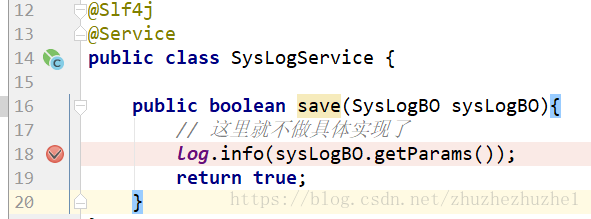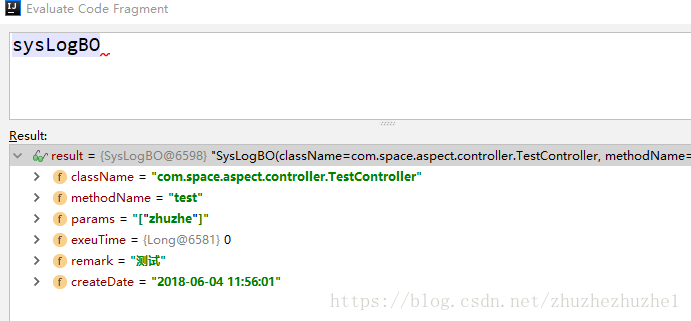本篇内容主要讲解“Springboot中如何用Aspect实现切面”,感兴趣的朋友不妨来看看。本文介绍的方法操作简单快捷,实用性强。下面就让小编来带大家学习“Springboot中如何用Aspect实现切面”吧!
今天我们来说说spring中的切面Aspect,这是Spring的一大优势。面向切面编程往往让我们的开发更加低耦合,也大大减少了代码量,同时呢让我们更专注于业务模块的开发,把那些与业务无关的东西提取出去,便于后期的维护和迭代。
好了,废话少说!我们直接步入正题
首先,我们先做一些准备工作。
1、新建一个Springboot工程
2、添加必要的依赖
AOP 必须
<dependency> <groupId>org.springframework.boot</groupId> <artifactId>spring-boot-starter-aop</artifactId> </dependency>
gson主要是我用于数据的处理,不是必须的
<dependency> <groupId>com.google.code.gson</groupId> <artifactId>gson</artifactId> <version>2.8.1</version> </dependency>
个人喜好
<dependency> <groupId>org.springframework.boot</groupId> <artifactId>spring-boot-devtools</artifactId> <scope>runtime</scope> </dependency> <dependency> <groupId>org.projectlombok</groupId> <artifactId>lombok</artifactId> <optional>true</optional> </dependency>
3、日志实体类和service
package com.space.aspect.bo;
import lombok.Data;
/**
* 系统日志bo
* @author zhuzhe
* @date 2018/6/4 9:36
* @email 1529949535@qq.com
*/
@Data
public class SysLogBO {
private String className;
private String methodName;
private String params;
private Long exeuTime;
private String remark;
private String createDate;
}
package com.space.aspect.service;
import com.space.aspect.bo.SysLogBO;
import lombok.extern.slf4j.Slf4j;
import org.springframework.stereotype.Service;
/**
* @author zhuzhe
* @date 2018/6/4 9:41
* @email 1529949535@qq.com
*/
@Slf4j
@Service
public class SysLogService {
public boolean save(SysLogBO sysLogBO){
// 这里就不做具体实现了
log.info(sysLogBO.getParams());
return true;
}
}4、定义日志注解
这里呢,我们记录日志使用注解的形式。所以,先定义一个注解
package com.space.aspect.anno;
import java.lang.annotation.*;
/**
* 定义系统日志注解
* @author zhuzhe
* @date 2018/6/4 9:24
* @email 1529949535@qq.com
*/
@Target(ElementType.METHOD)
@Retention(RetentionPolicy.RUNTIME)
@Documented
public @interface SysLog {
String value() default "";
}5、声明切面,完成日志记录
以上4点我们的准备工作已经完成。接下来就是重点了
这里需要你对AOP有一定的了解。起码知道切点表达式、环绕通知、前置通知、后置通知等。。。
package com.space.aspect.aspect;
import com.google.gson.Gson;
import com.space.aspect.anno.SysLog;
import com.space.aspect.bo.SysLogBO;
import com.space.aspect.service.SysLogService;
import org.aspectj.lang.ProceedingJoinPoint;
import org.aspectj.lang.annotation.Around;
import org.aspectj.lang.annotation.Aspect;
import org.aspectj.lang.annotation.Pointcut;
import org.aspectj.lang.reflect.MethodSignature;
import org.springframework.beans.factory.annotation.Autowired;
import org.springframework.stereotype.Component;
import java.lang.reflect.Method;
import java.text.SimpleDateFormat;
import java.util.ArrayList;
import java.util.Date;
import java.util.List;
/**
* 系统日志切面
* @author zhuzhe
* @date 2018/6/4 9:27
* @email 1529949535@qq.com
*/
@Aspect // 使用@Aspect注解声明一个切面
@Component
public class SysLogAspect {
@Autowired
private SysLogService sysLogService;
/**
* 这里我们使用注解的形式
* 当然,我们也可以通过切点表达式直接指定需要拦截的package,需要拦截的class 以及 method
* 切点表达式: execution(...)
*/
@Pointcut("@annotation(com.space.aspect.anno.SysLog)")
public void logPointCut() {}
/**
* 环绕通知 @Around , 当然也可以使用 @Before (前置通知) @After (后置通知)
* @param point
* @return
* @throws Throwable
*/
@Around("logPointCut()")
public Object around(ProceedingJoinPoint point) throws Throwable {
long beginTime = System.currentTimeMillis();
Object result = point.proceed();
long time = System.currentTimeMillis() - beginTime;
try {
saveLog(point, time);
} catch (Exception e) {
}
return result;
}
/**
* 保存日志
* @param joinPoint
* @param time
*/
private void saveLog(ProceedingJoinPoint joinPoint, long time) {
MethodSignature signature = (MethodSignature) joinPoint.getSignature();
Method method = signature.getMethod();
SysLogBO sysLogBO = new SysLogBO();
sysLogBO.setExeuTime(time);
SimpleDateFormat dateFormat = new SimpleDateFormat("yyyy-MM-dd hh:mm:ss");
sysLogBO.setCreateDate(dateFormat.format(new Date()));
SysLog sysLog = method.getAnnotation(SysLog.class);
if(sysLog != null){
//注解上的描述
sysLogBO.setRemark(sysLog.value());
}
//请求的 类名、方法名
String className = joinPoint.getTarget().getClass().getName();
String methodName = signature.getName();
sysLogBO.setClassName(className);
sysLogBO.setMethodName(methodName);
//请求的参数
Object[] args = joinPoint.getArgs();
try{
List<String> list = new ArrayList<String>();
for (Object o : args) {
list.add(new Gson().toJson(o));
}
sysLogBO.setParams(list.toString());
}catch (Exception e){ }
sysLogService.save(sysLogBO);
}
}6、测试
接下来,我们就来测试一下吧
package com.space.aspect.controller;
import com.space.aspect.anno.SysLog;
import org.springframework.web.bind.annotation.GetMapping;
import org.springframework.web.bind.annotation.RequestParam;
import org.springframework.web.bind.annotation.RestController;
/**
* @author zhuzhe
* @date 2018/6/4 9:47
* @email 1529949535@qq.com
*/
@RestController
public class TestController {
@SysLog("测试")
@GetMapping("/test")
public String test(@RequestParam("name") String name){
return name;
}
}启动项目,访问我们的test方法。
我们在service里打一个断点


可以看到,我们所需要的值都成功拿到了。
这样,我们就成功实现了使用Aspect实现切面记录日志。
源码:https://github.com/zhuzhegithub/springboot-aop-aspect
项目每次写controller方法,都要在开始和结束打印一行日志表示方法开始和结束,每个方法都要写,太过于麻烦和重复,想到了spring的aop切面,所以使用@Aspect切面和自定义log注解实现了下切面日志打印.
AOP(Aspect Orient Programming),直译过来就是 面向切面编程。AOP 是一种编程思想,是面向对象编程(OOP)的一种补充,在程序开发中主要用来解决一些系统层面上的问题,比如日志,事务,权限等等,这里主要是做一下方法的日志打印。
@Aspect:作用是把当前类标识为一个切面供容器读取
@Pointcut:Pointcut是植入Advice的触发条件。每个Pointcut的定义包括2部分,一是表达式,二是方法签名。方法签名必须是 public及void型。可以将Pointcut中的方法看作是一个被Advice引用的助记符,因为表达式不直观,因此我们可以通过方法签名的方式为 此表达式命名。因此Pointcut中的方法只需要方法签名,而不需要在方法体内编写实际代码。
@Around:环绕增强,相当于MethodInterceptor
@AfterReturning:后置增强,相当于AfterReturningAdvice,方法正常退出时执行
@Before:标识一个前置增强方法,相当于BeforeAdvice的功能,相似功能的还有
@AfterThrowing:异常抛出增强,相当于ThrowsAdvice
@After: final增强,不管是抛出异常或者正常退出都会执行
声明一个注解要用到的东西
修饰符:访问修饰符必须为public,不写默认为pubic;
关键字:关键字为@interface;
注解名称:注解名称为自定义注解的名称,使用时还会用到;
注解类型元素:注解类型元素是注解中内容,可以理解成自定义接口的实现部分;
自定义log注解代码
/**
* 日志注解
*
* Target:用于明确注解用于目标类的哪个位置
* Retention:用于标识自定义注解的生命周期
* RUNTIME:生命周期持续到运行时,能够通过反射获取到
* Documented:用于标识自定义注解能够使用javadoc命令生成关于注解的文档
*
* @author xxx
* @date 2020/xx/xx
*/
@Target(ElementType.METHOD)
@Retention(RetentionPolicy.RUNTIME)
@Documented
public @interface LogMessage {
/**
* 使用value值,在使用注解的时候,不需要写@LogMessage(value=xxx),直接写@LogMessage(xxx)即可
*/
String value() default "";
/**
* 别名使用value,所以在使用注解时,既可以写@LogMessage(xxx),也可以写@LogMessage(description=xxx)
*/
@AliasFor("value")
String description() default "";
/**
* 是否打印参数
*/
boolean parameterPrint() default true;
}apsect切面类注解
/**
* 日志切面类
* Aspect :作用是把当前类标识为一个切面供容器读取
*
* @author xxx
* @date 2020/xx/xx
*/
@Slf4j
@Aspect
@Component
public class LogAspect {
/**
* 前置增强,目标方法执行之前执行
* within:用于匹配所以持有指定注解类型内的方法
* annotation:用于匹配当前执行方法持有指定注解的方法
* within(com.xxx.xxx..*) com.xxx.xxx包及子包下的任何方法执行
*
* @param joinPoint
* @param logManage
* @return void
* @author xxx
* @date 2020/xx/xx
*/
@Before("within(com.xxx.xxx..*) && @annotation(logManage)")
public void addBeforeLogger(JoinPoint joinPoint, LogMessage logManage) {
log.info("[{}] Start", logManage.value());
// 处理参数
try {
if (logManage.parameterPrint()) {
Object[] args = joinPoint.getArgs(); // 参数值
String[] argNames = ((MethodSignature) joinPoint.getSignature()).getParameterNames();
Map<String, Object> paramsMap = new HashMap<>();
StringBuilder sb = new StringBuilder();
if (args != null && args.length > 0) {
for (int i = 0; i < args.length; i++) {
paramsMap.put(argNames[i], args[i] != null ? args[i].toString() : "");
}
for (Map.Entry<String, Object> entry : paramsMap.entrySet()) {
sb.append(entry.getKey()).append(":").append(entry.getValue()).append(";");
}
}
log.info("[方法名称:{},方法参数:{}", ((MethodSignature) joinPoint.getSignature()).getMethod().getName(), sb.toString());
}
} catch (Exception e) {
log.info("切面日志打印异常!");
}
}
/**
* 返回增强,目标方法正常执行完毕时执行
*
* within:用于匹配所以持有指定注解类型内的方法
* annotation:于匹配当前执行方法持有指定注解的方法
* within(com.xxx.xxx..*) com.xxx.xxx 包及子包下的任何方法执行
*
* @param joinPoint
* @param logManage
* @return void
* @author xxx
* @date 2020/xx/xx
*/
@AfterReturning("within(com.xxx.xxx..*) && @annotation(logManage)")
public void addAfterReturningLogger(JoinPoint joinPoint, LogMessage logManage) {
log.info("[{}] End", logManage.value());
}
}controller中使用
@LogMessage("测试日志打印")
@GetMapping(value = "/test", produces = MediaType.APPLICATION_JSON_UTF8_VALUE)
public void xxx() {
log.info("test");
}这样在方法执行前和返回后都会打印日志,只需要在想要打印日志的方法上添加@LogMessage("")注解就可以了。
到此,相信大家对“Springboot中如何用Aspect实现切面”有了更深的了解,不妨来实际操作一番吧!这里是亿速云网站,更多相关内容可以进入相关频道进行查询,关注我们,继续学习!
免责声明:本站发布的内容(图片、视频和文字)以原创、转载和分享为主,文章观点不代表本网站立场,如果涉及侵权请联系站长邮箱:is@yisu.com进行举报,并提供相关证据,一经查实,将立刻删除涉嫌侵权内容。